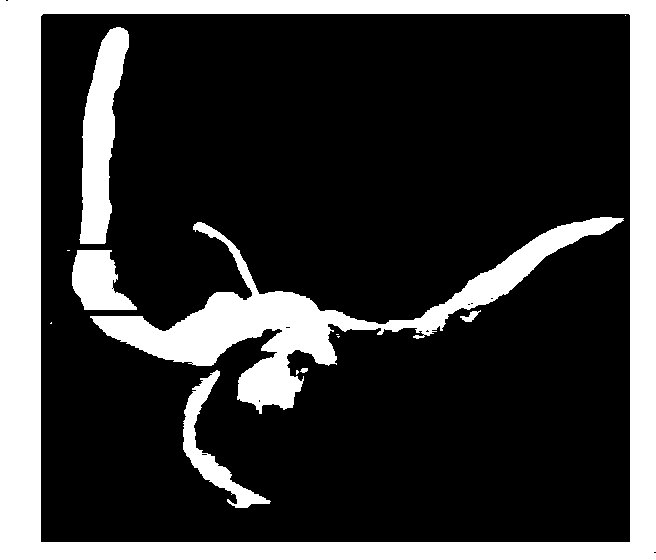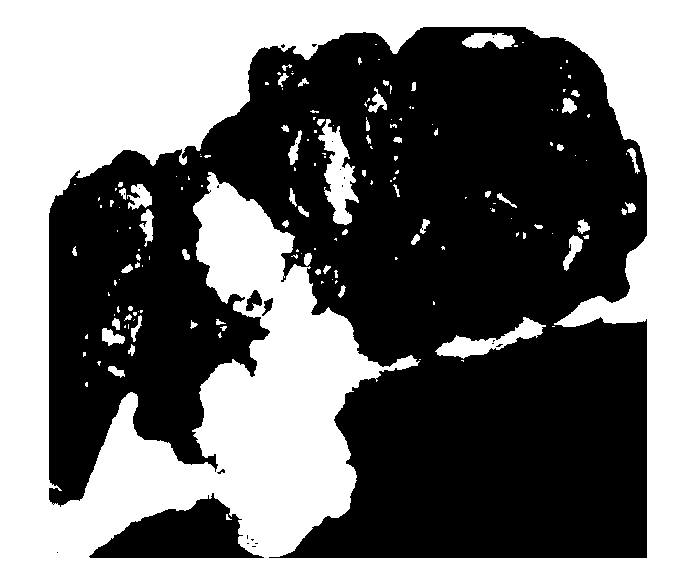Method for transforming exogenous gene by using maize coleoptile joint induced calluses
A callus, foreign gene technology, applied in horticultural methods, botanical equipment and methods, introduction of foreign genetic material using vectors, etc., can solve the problems of genotype limitation, low transformation rate, difficulty in regeneration, etc. The effect of efficiency, strong transformation ability and convenient material acquisition
- Summary
- Abstract
- Description
- Claims
- Application Information
AI Technical Summary
Problems solved by technology
Method used
Image
Examples
Embodiment 1
[0047] Example 1 Induction of Corn Seed Coleoptile Node Callus
[0048] 1. Seed sterilization
[0049] First, clean up the sundries in the corn seeds, select the full and complete seeds, and then put them in a container and wash them with distilled water 3 times, during which time they shake vigorously to clean up the residues on the attached surface. Soak in 75% alcohol for 3 minutes on the ultra-clean bench, then soak in 5.25% sodium hypochlorite for 20 minutes, and finally rinse with sterilized water for 5-6 times.
[0050] 2. Germination culture
[0051] Place the sterilized seeds in the germination medium, and pay attention to horizontally inoculate the embryos of the seeds in the germination medium. In the culture room (16h / d light, light intensity 80-100μE / m 2 / s, temperature 26-28℃) for 7-10 days.
[0052]The above germination medium is MS + maltose 40g / L + enzyme hydrolyzed casein 0.1g / L + glutamine 0.5g / L + MES (2-morpholineethanesulfonic acid) 2g / L + MgCl 2 6H2...
Embodiment 2
[0062] Example 2 Transformation and regeneration of coleoptile node callus
[0063] 1. Agrobacterium Preparation
[0064] (1) Liquid Agrobacterium preparation method
[0065] Streak activated strains in LB solid medium. The petri dish was sealed with Parafilm, and placed upside down in a 28-degree incubator for 2 days; the petri dish with Agrobacterium was placed in the refrigerator; in the afternoon of two days before infecting the explant, a single colony of Agrobacterium was picked, Inoculate in a 250ml flask containing 25ml LB liquid medium (the antibiotics corresponding to the plasmid / strain should be added to the LB liquid medium). Place the flask in a shaker at 150rpm and culture overnight at 26 degrees in the dark; the next morning, dilute Agrobacterium at a concentration of 1:5 (that is, add 10ml of bacterial solution to 40ml of fresh LB liquid medium with antibiotics) ; Shake the bacteria until the afternoon of the same day, divide 50ml of the bacterial solution i...
Embodiment 3
[0086] Example 3 PCR detection of transgenic corn
[0087] 1. Extraction of DNA from maize leaves (CTAB method)
[0088] Cut the 2-3cm long transgenic corn plant leaves and cut them into pieces, put them into a 2.0ml centrifuge tube, add a steel ball; place the centrifuge tubes with the leaves and steel balls in the centrifuge tube rack dedicated to the sampler in order (8×5), soak the whole in a fresh-keeping box filled with liquid nitrogen for 1-2min; put the frozen centrifuge tube rack into the sampler, and sample at 1200 rpm for 20s; add 600μL CTAB extract ( 65°C preheating), 65°C water bath for 30min, take out and invert 1-2 times in the middle; add an equal volume (600uL) of chloroform:isoamyl alcohol (24:1) extract, close the lid tightly, mix up and down, and let stand 10-15min. Centrifuge at 11,000 rpm for 5 minutes until the phases are clearly separated; absorb 500 μL of the supernatant, transfer it to a new 1.5 mL sterilized centrifuge tube, add 2 / 3 volume of isopr...
PUM
 Login to View More
Login to View More Abstract
Description
Claims
Application Information
 Login to View More
Login to View More - R&D
- Intellectual Property
- Life Sciences
- Materials
- Tech Scout
- Unparalleled Data Quality
- Higher Quality Content
- 60% Fewer Hallucinations
Browse by: Latest US Patents, China's latest patents, Technical Efficacy Thesaurus, Application Domain, Technology Topic, Popular Technical Reports.
© 2025 PatSnap. All rights reserved.Legal|Privacy policy|Modern Slavery Act Transparency Statement|Sitemap|About US| Contact US: help@patsnap.com



